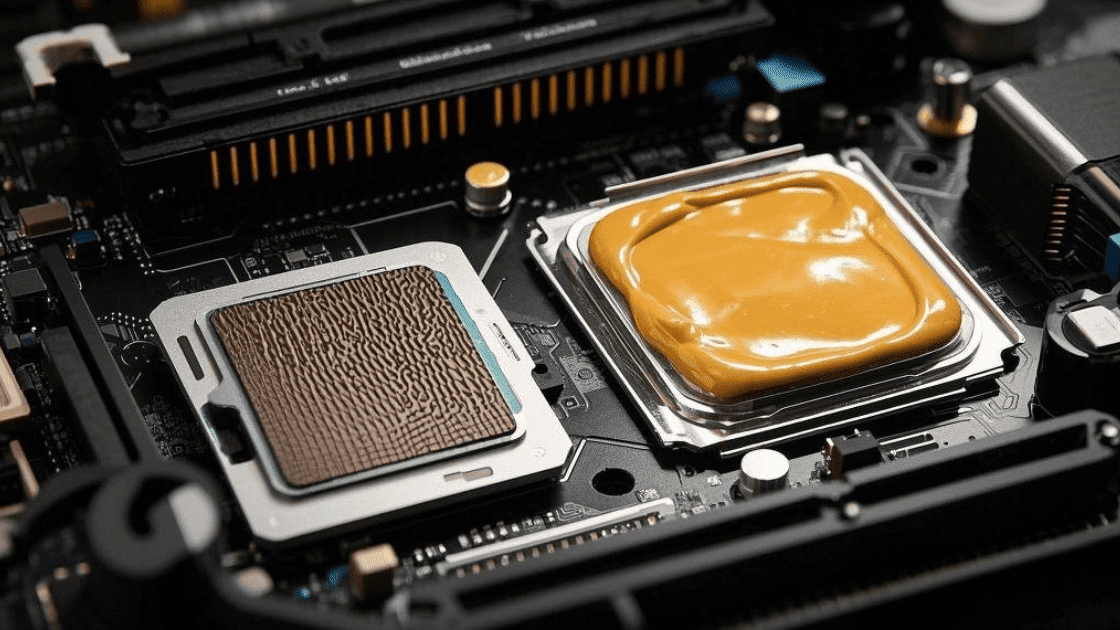Advancements in modern electronics have made it crucial to choose a specific thermal interface material for managing rising temperatures. Because every thermal interface material serves the same, but every component does not require the same. Several factors are involved in creating relevancy between them. Keeping these factors on the priority list, we have chosen to write a thorough guide on the Thermal Pad vs. Thermal Gel.
We will cover all about thermal pad and thermal gel, their core features, relevant applications, their comparison, where to use thermal pad and thermal gel, and many more. This comparison guide at the end will be enough to assist businesses and consumers in choosing the specific thermal product that meets their requirements perfectly. Let’s move forward towards the in-depth detail of the comparison.
Thermal Pad vs. Thermal Gel
– Thermal Pad
The thermal pad is a material that transfers heat elements and fills up air gaps in electronic components. It is a mixture of silicone as a base with other polymers including graphite, acrylic, polyester, aluminium, and fibreglass. A thermal pad performs pretty well in its domain and is the most widely used thermal product.
Key Features
- A quality thermal pad offers a high thermal conductivity of 1-20 W/mK.
- It offers an operating temperature range of -50 to +200°C degrees Celcius.
- Thermal Pad is soft/compressible and offers great conformability.
- It offers electrical insulation to avoid short-circuits and other damages.
- Thermal Pad is easy to apply and easy to remove.
- It is non-toxic and safe from harmful chemicals.
– Thermal Gel
A thermal gel is also a heat-transferring material one uses in electronic components. It effectively transfers the heat from the components to the heat sink and covers air gaps efficiently. Thermal gel is manufactured using fillers (aluminium oxide, boron nitride, silicon dioxide, zinc oxide) with multiple carrier fluids.
Key Features
- Thermal Gel features a thermal conductivity of 1-15 W/mK.
- It features an operating temperature range of -40 to +200 degrees Celcius.
- Thermal Gel is easy to apply & also offers reusability.
- It never becomes dry and lasts longer.
- Thermal Gel is also soft and flowable in nature.
Comparison Based on Features
– Thermal Conductivity
Generally, a higher thermal conductivity indicates better heat transfer. As per statistics, a thermal pad usually offers more thermal conductivity than a thermal gel. As mentioned above, the thermal conductivity range of the thermal pad is 1-20 W/mK while the range of the thermal gel is 1-15 W/mK. Apart from that, both offer stable electrical insulation. So we can consider the results between Thermal Pad vs. Thermal Gel in the port of Thermal Pad.
– Operating Temperature Range
The operating temperature range means at which minimum or maximum temperature level a thermal interface material can work perfectly. The thermal pad and thermal compound both offer almost the same performance. A thermal pad features a temperature range of -40 to +200 degrees Celcius. Similarly, a thermal gel features a temperature range of -50 to +200 degrees Celcius.
– Physical Nature
In actuality, both thermal pad and thermal gel are soft physically. However thermal gel has an edge over the thermal pad in softness and flowability. The thermal pad is shaped into various dimensions and thicknesses while the thermal gel shapes accordingly after application. So, we can declare thermal gel a clear choice due to its softness and spreading capabilities.
– Applications Compatibility
Talking about application compatibility, both thermal interface materials offer huge and similar compatibility. Thermal pad and thermal gel are compatible with CPUs, GPUs, Consoles, LED lights, EV Batteries, Medical equipment, and Military Equipment. Here, choosing the specific one depends upon the preference of businesses/consumers according to their requirements and component specifications.
– Easy to Apply
It will hardly take a couple of seconds for a thermal pad to apply. You only need to cut the thermal pad into the required sizes and place it on the components. On the other end, a deep understanding of the quantity and application methods is needed to apply thermal gel. Less or more amount can directly impact the overall performance in heat management. If you want ease of installation then a thermal pad can serve well.
– Cost/Prices
Cost factors are always considered important by businesses/consumers as they impact their budgets. If we overview the cost of the thermal pad and thermal gel. The thermal pad is a more economical option compared to thermal gel. We can not say that a thermal gel is expensive, but the cost is based on its advancement, performance, and high-end usage.
Comparison Table
| Features | Thermal Pad | Thermal Gel |
|---|---|---|
| Thermal Conductivity | Higher | Lower |
| Operating Temperatures | Almost Equal | Almost Equal |
| Physical Nature | Semi-Soft | Soft |
| Application Compatibility | Similar | Similar |
| Easy to Apply | Easier | Tricky |
| Cost or Prices | Economical | Expensive |
Where to Use Thermal Pad
- Where ease of application is the user’s preference.
- Where an economical budget is the user’s preference.
- Where the long-lastingness of thermal interface material is the user’s preference.
- Where there is a need for the reusability of the product.
Where to Use Thermal Gel
- Where there is high-end usage of electronic components.
- Where one can easily manage the maintenance of TIM.
- Where a high budget range is not a big deal.
- Where there is a need to fill up even micro-level air gaps.
Jiuju as TIM Supplier
If you belong to the business industry and searching for a reputable manufacturer to get thermal management solutions. JiuJu can be your future partner offering a wide range of thermal interface materials including thermal paste, pads, gels, grease, and tapes.
JiuJu always prioritizes offering its clients discounted rates and many other benefits in the delivery and transportation of their products. The company has been operating in the market for 20 years and is engaged with 500+ business partners across the globe with positive feedback on JiuJu’s products.
Apart from that, the monthly production capacity at JiuJu easily crosses the huge figure of 20 tons. This is only because of the skilled team, advanced manufacturing machinery, quality material, and up-to-date R&D department. So contact the customer support team with your queries and get the quotations.
Read Also: Thermal Gel vs Thermal Potting Gel – Comparison
Key Takeaways
We can conclude from this comparison between the Thermal Pad vs. Thermal Gel that each is preferred based on the requirements and specifications of the product. Both thermal pad and thermal gel have a winning edge over one another. Businesses/consumers looking for a budget-friendly, easy-to-apply, and long-lasting thermal product can prefer thermal pads., Similarly, businesses/consumers looking for thermal products for high-end usage and regular maintenance can prefer thermal gel. In the end, we can say that both serve as thermal management products but with different approaches and aspects.
Here is the official link to JuiJu Thermal Products, don’t forget to check, if you





